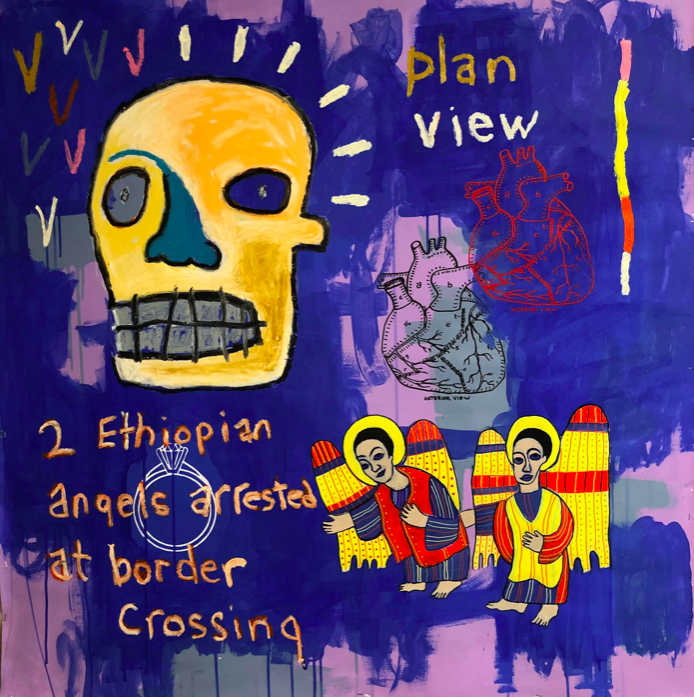Born in Norfolk, Virginia, in 1955, Peter Pryor’s journey to becoming an artist is a testament to the strength of the human will. As the oldest of five siblings, Pryor’s early life was marked by constant movement and adversity as he navigated the challenges of foster care. Yet, it was through the therapeutic power of art that he found solace and purpose, shaping the trajectory of his life.

Initially drawn to the humanities with dreams of becoming a school teacher, Pryor’s path took an unexpected turn when he discovered his passion for the fine arts during his college years. It was the encouragement of his fine arts professor, Harper T. Phillips, that steered him towards Pratt Institute in Brooklyn, New York. This pivotal moment marked the beginning of Pryor’s dedicated journey as an artist, a path that continues to unfold, both in his art and as a human being.
Pryor’s early years at Pratt were marked by a stark reality check. The faculty there emphasized the challenges of making a secure income as a fine artist and encouraged students to acquire collateral skills to sustain their art. The notion that a career in the fine arts could be uncertain did not deter Pryor; instead, it grounded him in the practicalities of the world he was entering.
To fund his artistic pursuits, Pryor explored a diverse range of jobs, from graphic design and woodworking to construction and drafting. These experiences not only provided him with financial stability but also revealed that various professions value artistic abilities. For Pryor, art was always at the core, driving him to earn enough money to sustain his creative endeavors.
As life unfolded, Pryor confronted the challenges of adulthood, including raising a family and managing financial responsibilities. The idyllic image of the struggling artist pursuing their craft in isolation gave way to the real-world demands that every individual faces. Nevertheless, Pryor persevered, keeping his art alive amidst life’s interruptions.
Throughout his career, Pryor’s artistic journey has taken him in diverse directions. He explored sculpture, performance art, music, film making, and traditional forms like painting and drawing. In the early ’90s, he decided to pursue a master’s degree in fine arts, aiming to secure a teaching position at a college. However, he encountered fierce competition in a saturated job market, where many artists shared his aspirations.
During the ’80s and ’90s, Pryor also navigated the rapidly evolving landscape of technology in art. As computers and the internet began to influence all aspects of life, Pryor experimented with recording, film, and performance art. Yet, he soon found himself drawn back to more direct and simpler art forms like painting and drawing, partly due to the frustrations associated with technology.
One of the practical questions that Pryor faced was how to sell performance art and other emerging art forms that lacked traditional avenues for monetization. Many artists in these new forms relied on grants, which were not always readily available. This reality underscored the notion that being an artist is not a traditional career; it’s a lifelong journey of self-expression and exploration.
For Pryor, art served as a lifeline throughout his life, helping him process the trauma he experienced in foster care. While he found solace in art and psychotherapy, tragically, two of his brothers, who faced similar childhood challenges, did not survive. He believes that a greater embrace of art in their lives might have made a difference, highlighting the power of art as a means of understanding and healing.
Art has always played an integral role in Pryor’s life, offering him a way to process his experiences and share them with the world. His artistic journey, with all its twists and turns, has shaped both his identity and his art. It’s a testament to the enduring power of passion and the ability of art to infuse meaning into life’s journey.
When asked about the pivotal moment when he decided to become an artist, Pryor reflects, “It’s almost like my art decided to choose me.” He transitioned from a humanities major to fine arts when he was around 21, recognizing the value of a well-rounded education in the fine arts, which fosters critical thinking, adaptability, and creativity—a foundation that serves students well in any career.
Reflecting on his career, Pryor emphasizes the importance of a formal fine arts education, noting that it equips individuals with the skills to navigate an ever-changing world. The ability to think critically, embrace change, and approach challenges with creativity is invaluable not only to artists but to all students preparing for the workforce.
Inspiration for Pryor’s art is deeply rooted in his love, passion, and personal life experiences. He sees his art as a means of contributing to the world, a way to communicate his perspective and connect with others on a profound level.
When offering advice to aspiring artists, Pryor keeps it simple: “You must have more than just skills or talent; you have to have a deep, unyielding passion, a desire to make it so important to your life that you will keep doing it no matter what.” His words underscore the essence of being an artist—a journey driven by passion and an unwavering commitment to self-expression.
As for his favorite books, Pryor’s love for reading is evident. His eclectic tastes range from history books, especially those about medieval history, to works on language, current affairs, and classics like Charles Dickens. He also appreciates contemporary literature, recommending John Kennedy Toole’s “Confederacy of Dunces” for its ability to evoke laughter, tears, and contemplation.
Peter Pryor’s artistic journey is a testament to the power of passion and resilience. His life experiences, challenges, and triumphs have shaped his art, and his art, in turn, has enriched his life. As he continues to create, he offers a lesson in the enduring nature of art—a journey that remains steadfast amidst the ever-changing currents of life.
